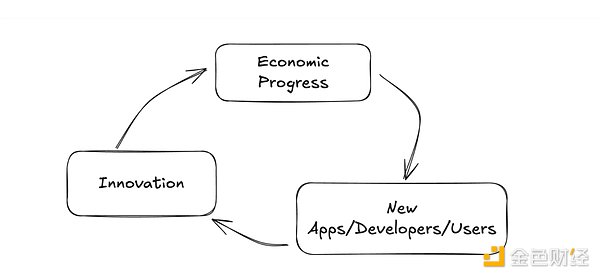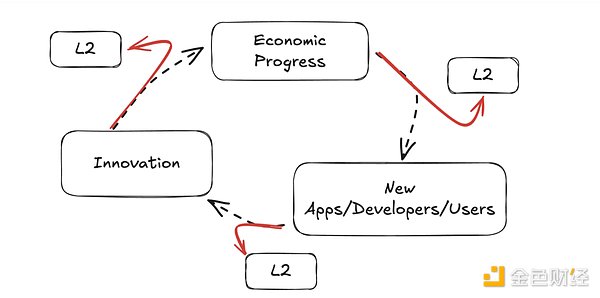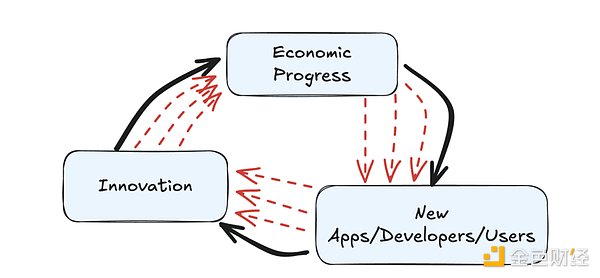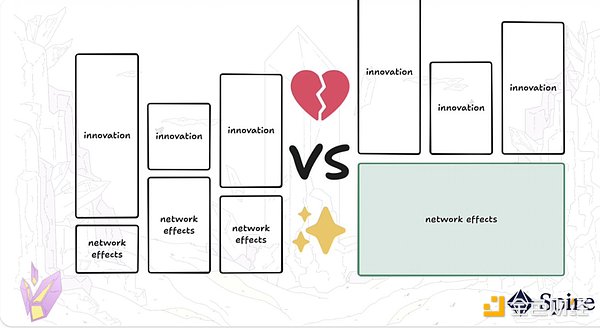Author: mteam.eth Source: Bankless Translation: Shan Ou Ba, Golden Finance
To become a successful blockchain, a positive cycle flywheel must be established, the structure of which is as follows:
Economic progress (such as TVL, price, revenue, transaction volume, etc.) brings attention and visibility to the chain, thereby: ↓
New applications can obtain financing, new developers are willing to learn this technology, and new users can also benefit from everything we have built to improve their lives, which will ultimately lead to: ↓
Innovation - Improvements in infrastructure and applications, improving efficiency, and exploring new use cases and architectures. The innovation phase is the most collaborative part of the cycle, but it is also the phase where natural incentives are most likely to make teams work independently. Innovation drives economic progress, and the cycle starts again.
The problem with Ethereum is very simple - we broke every link of this flywheel.

Note: This article focuses on Ethereum's high-level technical roadmap and does not involve the evolution of its social layer. But the two must exist together to present a complete picture.
First, acknowledge the problem
New applications, developers, and users are all on Layer-2! Innovation happens on Layer-2! Even economic progress is leaning towards Layer-2.
If these L2s can feed back the entire flywheel cycle, then this is not a problem - but the reality is that they often don't do this.

So, what is the root cause of this flywheel break?
Since 2020, Ethereum has viewed Rollup as the only scalability path and has seriously overestimated the potential contribution of L2 to the Ethereum flywheel.
Rollup is positioned as a scaling solution. Compared with sharding, it looks simpler, does not weaken the security of the Ethereum main chain, and even brings stronger composability.
But Rollup is not just a scaling architecture, it is also an incentive architecture. Its basic logical path can be simplified as follows:
We need to scale Ethereum.
To scale a blockchain with the characteristics we need, some form of sharding is necessary.
Sharding is too complex and has other problems in protocol layer implementation.
Therefore, Rollup is the only way to scale.
Point 2 of this logic is a major misjudgment in my opinion. In practice, we are clearly wrong (at least to some extent). For example, Solana and Monad have demonstrated a roadmap to achieve scalability without relying on any form of sharding. At the same time, many Ethereum core developers have demonstrated that we can significantly increase the performance potential of L1.
While I don’t think a single chain can handle all needs, we are clearly rushing to the end before exploring L1 scaling opportunities.
The reasoning in point 4 is also untenable. We have failed to properly assess the potential negative impact of the "Rollup-centric roadmap" on the Ethereum main chain network effect flywheel.
Ideal flywheel
I think we can rebuild Ethereum's network effect flywheel:

Instead of letting the network effect be drawn out of the flywheel, it is better to let Layer-2 accelerate the transmission of network effects between each other through collaboration.
Specifically, this means:
providing almost unlimited elastic expansion capabilities as an overflow layer for the main chain;
promoting customization, specialization, and bold experimental exploration;
attracting users and developers to settle in;
driving the revenue growth of the entire Ethereum ecosystem while increasing the revenue of Ethereum L1 itself;
maintaining a high degree of composability with Ethereum.
This interactive mechanism is not only beneficial to Ethereum, but also to Layer-2 - a rising tide lifts all boats.
vccccccccccc4

Solid Foundation
To effectively restart this flywheel, we need a strong layer network (L1) -
a main chain worthy of being combined;
an ETH worthy of holding as a treasury asset;
a platform that can serve as an innovation coordination center.
How to do it? The answer is simple: Substantially expand L1.
We should start with innovation at the L1 level.
This is for three main reasons:
L1 expansion can enhance network effects under the ideal flywheel;
L1 expansion will increase the competitive threshold of L2;
L1 expansion also directly helps L2! (Especially the kind of L2 I’ll discuss in the next section)
Most readers probably know what L1 scaling means in practice: Increase TPS and gas limits per second while reducing block times.
We want to make Ethereum L1 the strongest settlement network and the strongest execution network.
All of this is the solid foundation that Layer-2 really needs.
Let Rollup return to the main stage
As L1 scales and builds its own network effects, we must hurry to optimize Layer-2 so that it can contribute to the ideal flywheel.
We need to strike a balance between the following two points:
If we turn to L1 expansion now, we must be careful not to completely alienate major L2 projects (of course, some L2s are not necessary to exist and should die).
I propose a simple Rollup design:
Rollup uses Ethereum as the data availability (DA) layer;
Rollup uses Ethereum for execution - that is, it is a native Rollup;
Rollup uses Ethereum for sorting - that is, it is a Rollup based on Ethereum;
Rollup uses ETH as the native gas token.
This kind of Rollup design is called "ultrasonic Rollup", or "based on + native Rollup. I have discussed this type of design in detail before.
However, on Ethereum today, ultrasonic Rollup is still not feasible.
To implement the "native" part, Ethereum needs to add an opcode called execution engine opcode through a hard fork.
There are also some problems in the actual implementation of sorting. And all these changes are closely related to L1 expansion.
From multiple choices to a single answer
Ethereum is building a top-level data availability (DA) service, based on Rollup is outputting sorting capabilities, and we are also continuing to improve,
Native Rollup will bring excellent execution performance.
The Ethereum mainchain integrates core Rollup services into a unified ultrasonic Rollup architecture.
While the chain can still remain modular (after all, the market is permissionless),
the services provided by Ethereum are so critical and complete that other competitors become irrelevant.
In this model, the logic of value capture (through fees) is very direct:
Provide the most valuable services, connect the largest synchronous economic zones, have the strongest economic security, the most censorship-resistant sorting capabilities, the most reliable settlement layer, and the most secure data availability layer.
The narrative naturally takes shape:"Ethereum is the best" → Ethereum is the best.
Expand the main chain,Let Rollup return to the main stage,Fully integrate everything. And complete all of this as soon as possible.
 Miyuki
Miyuki









